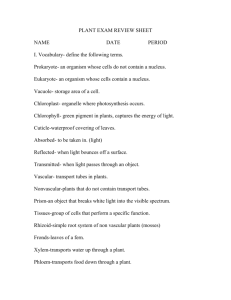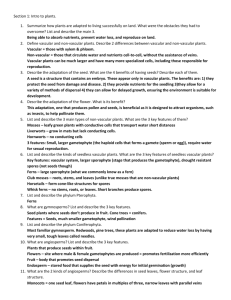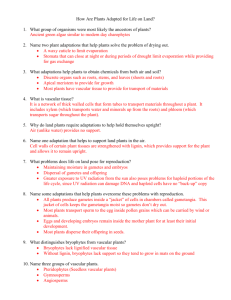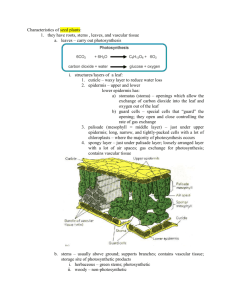Plants Diversity Guided Notes
advertisement
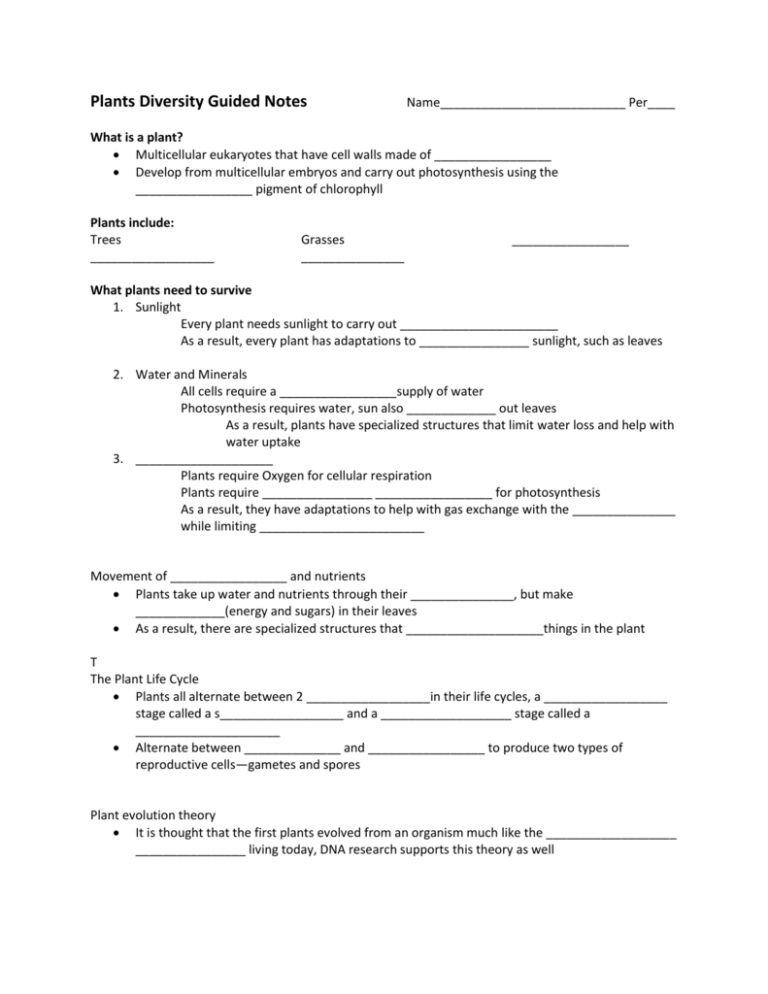
Plants Diversity Guided Notes Name___________________________ Per____ What is a plant? Multicellular eukaryotes that have cell walls made of _________________ Develop from multicellular embryos and carry out photosynthesis using the _________________ pigment of chlorophyll Plants include: Trees __________________ Grasses _______________ _________________ What plants need to survive 1. Sunlight Every plant needs sunlight to carry out _______________________ As a result, every plant has adaptations to ________________ sunlight, such as leaves 2. Water and Minerals All cells require a _________________supply of water Photosynthesis requires water, sun also _____________ out leaves As a result, plants have specialized structures that limit water loss and help with water uptake 3. ____________________ Plants require Oxygen for cellular respiration Plants require ________________ _________________ for photosynthesis As a result, they have adaptations to help with gas exchange with the _______________ while limiting ________________________ Movement of _________________ and nutrients Plants take up water and nutrients through their _______________, but make _____________(energy and sugars) in their leaves As a result, there are specialized structures that ____________________things in the plant T The Plant Life Cycle Plants all alternate between 2 __________________in their life cycles, a __________________ stage called a s__________________ and a ___________________ stage called a _____________________ Alternate between ______________ and _________________ to produce two types of reproductive cells—gametes and spores Plant evolution theory It is thought that the first plants evolved from an organism much like the ___________________ ________________ living today, DNA research supports this theory as well This cladogram illustrates the evolutionary relationship between the 4 major divisions of plants 1. Bryophytes o o o o o o Mosses and their relatives are called bryophytes or __________________ plants (Vascular tissue is specialized tissue used to conduct water and nutrients) Life cycles depend on ____________ for reproduction Produce ____________ that must swim through water to reach the __________ of another byrophytes Can only draw up water by _________________ only a few centimeters above the ground Typically low-growing plants that are found in ____________, shaded areas Include Mosses, Liverworts, and Hornworts Mosses Grow best in moist _________________________ They can withstand _______________ climates Are the most ____________________ plant type in __________ regions **Have _____________ instead of roots Rhizoids are long thin cells that _______________ the plant and absorb water and minerals Liverworts and Hornworts Both rely on moist environments and get their name from their ______________ Bryophytes life cycle o Just like most plants, bryophytes have a sporophyte and gametophyte stage o The _____________________ is dominant and carries out photosynthesis 2. Seedless Vascular Plants o ________________ tissue is specialized to conduct water and nutrients throughout a plant, these specialized cells are called Tracheids Tracheids are ______________ cells with thick cell walls that resist pressure There are 2 types of vascular tissue made up of tracheids: ___________ and Phloem Xylem and ____________ Xylem is a transport subsystem that carries ________________ upward from the roots to _____________ part of the plant Phloem transports solutions of _________________ and _______________________ produced by photosynthesis o Both can move fluids through the plant body, even ________________ the force of gravity Seedless vascular plants include: Club mosses, horsetails, and ferns Club Mosses (lycophyta) Are small plants that live in moist ________________ Resemble _________________ pine trees and are often called “ground pines” Horsetails (arthryophyta) Only has one living variety alive called __________________, because it looks like a horsetail and grows about 3 feet tall Ferns (pterophyta) Most diverse group of ________________ vascular plants with over _____________________ different species living today Have strong ________________, rhizomes (underground stems), and large leave called _________________ Do well in _________________ light and humid conditions Life Cycle of Ferns/vascular plants Have a life cycle that is dominated by the __________________ sporophyte 3. Seed Plants Have quickly become the ___________ __________________ group of species of organisms on land Are divided into 2 distinct groups 1. _________________________: bear their seeds directly on the surfaces of cones, cone bearing plants Include the pine, cycads, ginkgoes, and gnetophytes 2. _________________________: known as flowering plants, bear their seeds within layers of tissue that protect the seed Include grasses, flowering trees and shrubs, and all flowers Advantages Reproduction is _____________ from water Adaptations that allow seed plants to reproduce without water include flowers or cones, the transfer of sperm by __________________, and the protection of embryos in seeds Like all other types of plants, they have a life cycle that ____________________ between gametophyte and sporophyte stages Cones and flowers are the ____________________ stage Pollen In seed plants the ______________ gametophyte is contained in a tiny structure called a pollen grain Pollen is carried by ____________ or ________________ to the female reproductive structures _________________________ is the transfer of pollen from the male reproductive structure to the female reproductive structure Seeds A seed is an __________________ of a plant that is encased in a protective covering and surrounded by a ___________________ of food Typically there is a protective _____________ _____________ that prevents the he seed from drying out Gymnosperms Are the most _______________ surviving seed plants Gymnosperm means “________________ seed,” referring to their exposed seeds There are 4 varieties of gymnosperms 1. __________________ Only have 70 known types, are quite unique They have reproductive scales that are clustered into cones 2. __________________ Are palm like plants that reproduce with large cones Today there are only 9 genera in existence 3. ___________________ Contains only one living species, Ginkgo biloba 4. ___________________ The most common gymnosperms, with 500+ species Includes pines, spruces, firs, cedars, sequoias, ___________________, junipers, and yews Some live over___________ years (bristlecone pine) Angiosperms—the Flowering Plants All are members of the phylum anthophyta Develop unique reproductive organs knows as ________________ Are an advantage because they attract animals that transport _____________ from flower to flower Flowers contain ________________, which surround and protect the seeds Ovaries develop into a ______________ after pollination to protect the seed Categorizing Angiosperms There are 3 different grouping categories we use to classify angiosperms 1. __________________________________ 2. Woody vs Herbaceous 3. Annual, _________________, Perennial Monocot VS Dicot Monocots and dicots are named for the number of seed leaves, or _________________, in the plant embryo Moncots have 1 seed leaf, dicots have 2 Cotyledon is the first leaf or the first pair of _________________ produced by the embryo of a seed plant Monocots Dicots o Single _________________ 2 cotyledons o Parallel veins in leaves Branched veins o Floral parts in multiples of____ Floral parts in multiples of _________ o Vascular bundles scattered Vascular bundles arranged in a ring throughout stem ___________________ o ________________ roots Woody VS Herbaceous Woody plants have cells with __________________ thick cell walls that support the plant body, have the characteristic we call _____________ Includes all _______________, shrubs, and vines (think grape vines) Herbaceous means that the plants do _________ produce wood as they grow A ___________________ is a great example Annuals, Biennials, and Perennials Annuals are flowering plants that complete their entire life cycle in a ____________ Biennials are plants that complete their life cycle in___________ years Perennials are plant the live _________________ ____________2 years Think?! What are the benefits to planting perennials in a garden?
